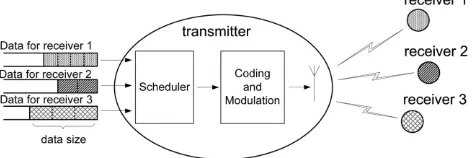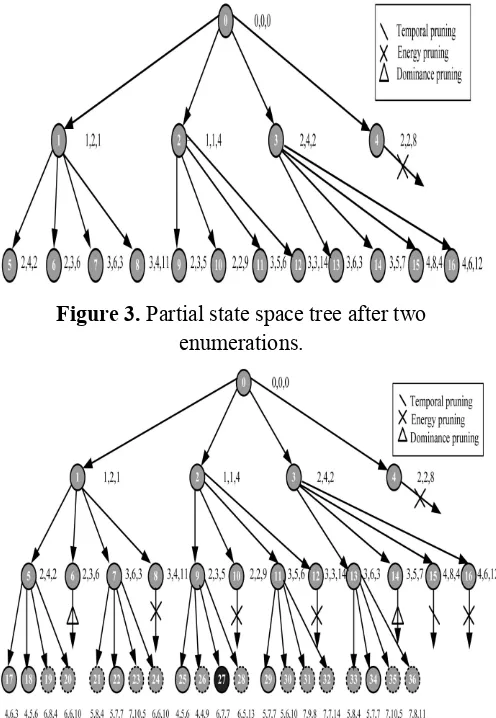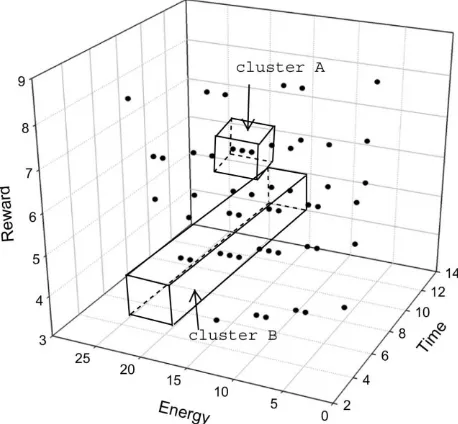CSEIT1726263 | Received : 25 Nov 2017 | Accepted : 21 Dec 2017 | November-December-2017 [(2)6: 946-951]
International Journal of Scientific Research in Computer Science, Engineering and Information Technology © 2017 IJSRCSEIT | Volume 2 | Issue 6 | ISSN : 2456-3307
946
Maximizing Booty in Wireless Networks
S. Lavanya
1, Lithiya Sara Babu
2, S. Seetha
31Assistant Professor , Department of Computer Science and Engineering, Karur college of Engineering,Karur,
Tamil Nadu, India
2Assistant Professor , Department of Computer Science and Engineering, Karur college of Engineering,Karur,
Tamil Nadu, India
3Assistant Professor , Department of Computer Science and Engineering, Karur college of Engineering,Karur,
Tamil Nadu, India
ABSTRACT
Power competence is an important sketch subject in portable devices with restricted authority supplies. In this paper, we study a booty-based packet scheduling problem in wireless environments. We consider a general scenario in which a source communicates with multiple destinations periodically. To promise timely transmission of data, each packet is associated with a delay constraint. The cyclic data streams have dissimilar significance levels, levels of data sizes and power functions. The more data a source delivers the more booty it obtains. Our objective is to develop schemes that selectively transmit data streams of different data sizes at different transmission rates so that the system booty can be maximized beneath given time and force constraints.
Keywords: Booty Maximization, Power-Aware Packet Scheduling, Wireless Networks, Embedded Systems.
I.
INTRODUCTION
ENERGY is a critical resource of wireless devices powered by battery with limited capacity. The increasing wireless transmission rate results in a rapid increase of the energy utilization of wireless devices. Reliable Content delivery over a wireless channel is a major source of energy expenditure. The energy disbursement for the transmission of a given amount of data can be reduced by reducing the transmission rate with proper wireless channel coding schemes. As applications are usually packet delivery delays, delay-sensitive should be allowed only if it is controllable. Different delay constraints were investigated in energy-efficient packet transmission, such as average delay [3], [6], a common deadline to all packets, and individual deadlines [5].Most existing work focus on the minimization of the total energy consumption under the timing constraints. Meanwhile, more and more embedded systems are being built with renewable energy sources, such as solar power, wind power, and mechanical power, from the environment. Generally, a wireless node may generate a significant amount of data in a networked environment in periodic cycle.
The cyclic data streams destined to various receivers may consume various amount of energy Wireless nodes powered by these energy sources are subjected to limited amount of energy which is collected in each period.
II.
SYSTEM MODEL AND PROBLEM
FORMULATION
In this part, we first define energy and data consumption models for the booty maximization problem. Then, we present a formulation of the booty maximization problem under given energy and time constraints.
A. Data Model
receiver. In recent years, we have seen the extension of the studies to a more general single transmitter- multiple-receiver model in which a wireless transmitter communicates with multiple receivers periodically, as shown in Figure 1.
Figure 1. Single-transmitter-multiple-receiver model in a single-hop wireless network.
In this model, the transmitter can only communicate with one receiver at a time and has an energy budget in each transmit cycle. Each receiver will receive data from the transmitter periodically. Every transmitter-receiver pair has a maximal amount of data to be transmitted in each time period. The receivers are located with different distances from the transmitter. The data to different receivers can be transmitted at different transmission rates.
We consider the transmission between each transmitter and receiver pair as a cyclic data stream and refer this as a task. It is a sequence of packet transmissions with the same characteristics that occurs at a regular interval. The number of tasks is always equal to the number of receivers in our model. All the transmission tasks are assumed to be independent and pre-emptive, scheduled by the Earliest Deadline First (EDF) policy. EDF is a popular scheduling policy for delay-sensitive wireless packet scheduling [11]. We choose EDF as the underlying policy because it has been shown to be optimal for deadline constrained scheduling over optimal link conditions under various modelling assumptions. The pre-emption can take place between transmissions of packets of different tasks. Practically, it can be implemented in a transmitter by rearranging packets in the transmission buffer by choosing those with the earliest deadlines. Similar pre-emptive model was assumed in [11].
B. Power Consumption Model
The power consumption of a wireless transmitter can be divided into two parts: Transmission power and
circuit power. The transmission power usually dominates since long-range communications (over 100 m) are common in wireless networks. To maintain the same diffusion rate, the required transmission power needs to increase with the distance between the receiver-transmitter pair to offset the transmission loss. In addition, the circuit power is expected to decrease as the IC technology advances. This part of power only occupies a small portion of the whole power consumption. So in our work, we assume the transmission power dominates the negligible circuit power. In our power model, we assume the channel is slowly time-varying, which means the channel condition will not change during transmission. Proper channel coding can reduce the energy consumption effectively during transmission.
We take the AWGN channel model as an example, which explains how energy, rate, and data size are related, with optimal channel coding.
provides us a base solution and could be extended by adjusting messages priorities dynamically online in a fading channel.
III.
DYNAMIC PROGRAMMING FOR THE
OPTIMAL SOLUTIONS
A general method of solving the optimal MMKP problem is to search the solution space until an optimal solution is found and confirmed. We can use breadth-first search to generate partial solution along with the sequence of receivers. This algorithm enumerates all possible data sizes and transmission rate for each receiver. This process can be visualized as a state space branch where each non leaf node in this tree has M -K children if there are M transmission rate levels and K data size levels for each receiver. Therefore, a naive algorithm would generate (M- K)i nodes at level i. The
state space can grow exponentially with the task number. To reach the solution in practical runtime, most researchers relied on heuristics to obtain approximated solutions or adapted approaches to reduce the computational complexity [10], [4]. These approaches are not readily applicable to our problem as our problem involves more decision factors. In the following, we develop a dynamic programming algorithm for the reward maximization optimization problem with two-dimension multiple choices of data size and transmission rate.
A. Dynamic Programming Algorithm
Consider a tuple (rik;tik;eik) as a state, where rik denotes the reward sum of the first i tasks corresponding to the accumulated transmission time uik and energy sum eik. We use a list to record all the states of task I Li =<(ri1;ti1;ei);(ri2;ti2;ei2); . . . ; (rini ;tini ;ein)> where ni is the number of states after the ith iteration. Due to the delay and energy constraints, branching from unpromising states that generate infeasible or non optimal solutions can be avoided. We summarize three circumstances, referred to pruning criteria, in which branches from a certain state will be pruned.
Table 1. An Example for Four Data Streams with Two Data Size Levels and Two Transmission Rate Levels
Figure 2. Partial state space tree after one enumeration
Figure 3. Partial state space tree after two enumerations.
Figure 4. The complete state space tree by pruning.
IV.
TIME-EFFICIENT APPROXIMATION
and computation resources. A near-optimal solution is more desirable if it can be completed in reasonable time while consuming reasonable computation resources. In this section, we will first propose a polynomial-time heuristic approach.
A. Polynomial-Time Approximated Approach (Clustering)
We develop a heuristic algorithm, named Clustering algorithm, to approximate the optimal solution to the proposed problem with a polynomial computational time complexity. This Clustering algorithm is novel for the proposed problem. The general idea of this algorithm can be traced back to data clustering in mathematics. This Clustering algorithm is based on a clustering property of the final states after we enumerate all the tasks. Figure5 shows the result if we plot the all of the final states for Table 1 after enumerating all possible combinations of data sizes and transmission rates into a 3D space with the coordinates of (booty; energy; time). We can find the nodes, representing the final states, are clustered instead of randomly scattering. This is attributed to the discrete levels of data sizes and transmission rates. Those nodes in the same cluster tend to have close reward values, energy consumption, and transmission time. We have similar observations about the intermediate results after each enumeration.
Figure 5. The reward-time-energy relationship in a 3D space.
During each enumeration, if we start from one cluster, the best solution generated from this cluster will have close reward values. If one node in this cluster can
generate the optimal solution, the others in the same cluster can produce near-optimal solutions as well. Keep only one node in each cluster and remove the others, we can still get the near-optimal solution though the optimal solution might be removed. If none of the nodes in this cluster can lead to the optimal solution, there would be no impact on the final solution if we keep one and remove the others. The benefit of this method is that it can reduce the state space significantly.
V.
PERFORMANCE EVALUATIONS
We simulate the following four algorithms in our experiment:
1. Dynamic programming algorithm for optimal solution:
We simulate this algorithm to obtain the optimal solution for reward maximization problem.
2. Polynomial-time Clustering algorithm (Clustering):
This is the proposed time-efficient Clustering algorithm for a near-optimal solution.
3. Greedy-pack and greedy-unpack algorithms: These two algorithms are adapted from as the competitors of proposed polynomial-time Clustering algorithm.
Though the reward maximization problem it is different from that in our work, the method of designing heuristic approaches is a general principle and can still be adapted to the problem studied in this paper. We compare the solutions of Clustering, greedy-pack, and greedy-unpack with the optimal solution obtained by the dynamic programming algorithm. We use the metric of normalized system reward to show how close these algorithms can approximate the optimal solution. We study the effect of different parameters on the simulation results and investigate the execution time cost for different algorithms. We conduct simulations to show to what degree our proposed dynamic programming algorithm can restrict the explosion of state space. In addition, we investigate the impact on approximation by choosing different numbers of clusters and strategies of representative node selection for Clustering algorithm
Delay-constrained package transmission in wireless communications. Power consumption in packet transmission can be reduced significantly by transmitting packets at a lower bit rate. Most existing studies on energy-efficient packet transmission focused on minimizing the energy expenditure subject to a time constraint. The time constraint can be in terms of average response time [3], [6], and a single deadline, to all packets. Both constraints do not put a limit to response time of individual packets, which may lead to unexpected large delay. To guarantee timely packet deliveries, it is more desirable to put a delay constraint to each packet [5]. They established the connection between maximum delay scheduling and a linear filter for an input. Two optimal scheduling approaches were proposed. One is a time variant policy which makes scheduling decisions according to each new packet arrival and uncompleted arrivals in the queue backlog. They derived relation between maximum packet transmission rate and packet arrival patterns so as to provide statistical response time and packet drop control. In this work, we study packet transmission with individual delay constraints to guarantee packet transmission time. We consider a general scenario in which a wireless transmitter communicates with multiple receivers. The transmitter generates data periodically and sends the data to corresponding receivers. The wireless transmitter is powered by renewable energy sources, such as solar panel. As a result, the transmitter needs to finish packet transmission subjected to both delay and energy constraints. Due to the constraints, it may not be able to send all the data. To ensure that the most valuable information is transmitted to the receivers, we associate a reward (value) to each packet. Our objective is reduced to maximizing the total reward under the time and energy constraints. Similar problems have been investigated in existing studies, [12]. studies of CPU reward maximization [1] in processors with infinite number of speed levels and continuous speed booty functions. Their approach is not applicable to our problem because there are a limited number of transmission rates for choice to maximize reward. The work in [4] was based on discrete CPU speed levels.
Heuristic approaches are developed to booty maximization without performance guarantee, which is a Multidimensional Knapsack Problem (d-KP) fundamentally. They targeted on a special case of task sets when all jobs share the same release times and deadlines. The problem we addressed is MMKP and we study a more general and challenging case without task timing constraint. Additionally, we propose an optimal solution for MMKP with pseudo polynomial time complexity while it is not available. In [4], proposed approximation algorithms for tasks with the same power functions when CPU speed change can be done at any time. While it is reasonable for tasks to have the same power functions in CPU tasks scheduling, the power characteristics can vary greatly in wireless communication with different transmission distances of receivers. In addition, we proposed optimal algorithm for booty maximization in pseudo polynomial time instead of approximation.
VII.
CONCLUSION
AWGN and fading channels. The AWGN based work provides us a base solution and could be extended by adjusting messages priorities dynamically online in a fading channel.
VIII.
REFERENCES
[1]. H. Aydin, R.G. Melhem, D. Mosse´, and P. Mejı´a-Alvarez, "Optimal Reward-Based Scheduling for Periodic Real-Time Tasks," IEEE Trans. Computers, vol. 50, no. 2, pp. 111-130, Feb. 2001.
[2]. S. Banerjee and A. Misra, "Adapting Transmission Power for Optimal Energy Reliable Multi-Hop Wireless Communication," Proc. Wireless Optimization Workshop (WiOpt), 2003. [3]. R.A. Berry and R.G. Gallager, "Communication over Fading Channels with Delay Constraints," IEEE Trans. Information Theory, vol. 48, no. 5, pp. 1135-1149, May 2002.
[4]. J.-J. Chen and T.-W. Kuo, "Voltage Scaling Scheduling for Periodic Real-Time Tasks in Reward Maximization," Proc. IEEE Real-Time Systems Symp. (RTSS), pp. 345-355, 2005. [5]. W. Chen and U. Mitra, "Energy Efficient
Scheduling with Individual Packet Delay Constraints," Proc. IEEE INFOCOM, 2006. [6]. B. Collins and R.L. Cruz, "Transmission Policies
for Time Varying Channels with Average Delay Constraints," Proc. Allerton Conf. Comm., Control, and Computing, 1999.
[7]. T.M. Cover and J.A. Thomas, Elements of Information Theory. Wiley, 1991.
[8]. S. Cui, A.J. Goldsmith, and A. Bahai, "Energy-Constrained Modulation Optimization," IEEE Trans. Wireless Comm., vol. 4, no. 5, pp. 2349-2360
[9]. J.K. Dey, J.F. Kurose, and D.F. Towsley, "Online Scheduling Policies for a Class of IRIS (Increasing Reward with Increasing Service) Real-Time Tasks," IEEE Trans. Computers, vol. 45, no. 7, pp. 802-813, July 1996.
[10]. K. Dudzinski and S. Walukiewicz, "Exact Methods for the Knapsack Problem and Its Generalizations," European J. Operational [11]. Research, vol. 28, no. 1, pp. 3-21, Jan. 1987. [12]. D. Ferrari and D.C. Verma, "A Scheme for
Real-Time Channel Establishment in Wide-Area Networks," IEEE J. Selected Areas in Comm., vol. 8, no. 3, pp. 368-379, Apr. 1990.


